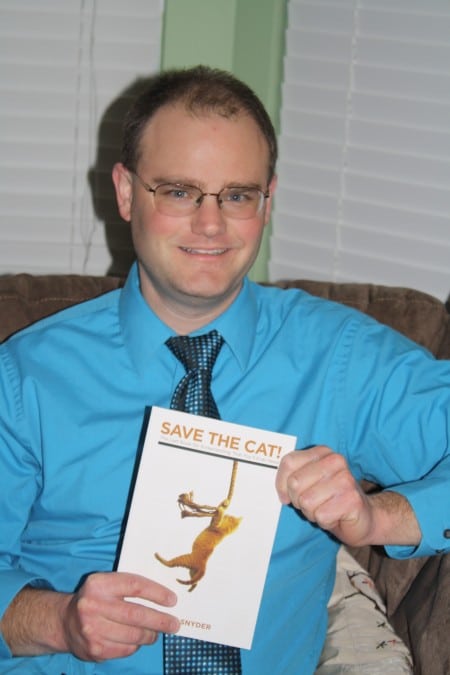
Our thanks to guest blogger Cory Milles, who has been teaching writing for nearly a decade. In his spare time, he writes Young Adult novels that seek to capture the power of story to transform his readers, and recently finished writing his fourth YA novel, tentatively titled Paradox. When he’s not writing, teaching, or listening to his collection of movie scores, he can usually be found reading more on the craft of writing. He writes a blog on writing to connect with his YA audience called “Attacking Ideas 101,” and his chapter on “LOST and the Power of Story,” about the hit TV show, will be featured in the upcoming book LOST Thought, due out March 9.
Students are taught about plot structure all throughout their school years. We’re all familiar with the basic outline for a traditional story: exposition, inciting incident, rising action, climax, falling action, and resolution. Of course, we occasionally see slight variations of this, but usually it’s predictable and basic.
And that’s the problem.
As a seventh grade teacher, I’ve learned that to help students truly make sense of a story, I need to go beyond the basics and give them a framework that both relates to them and challenges them. Earlier in the school year, I introduced Blake Snyder’s Ten Story Types to them as we discussed genre. Students immediately incorporated these into their daily discussions, even applying them outside of the classroom.
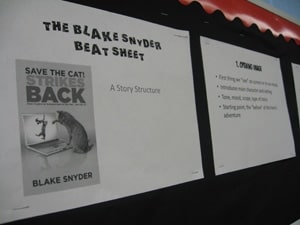
So as I began our unit on reading fiction, I wanted to do the same thing for my classes, to give them a framework for a deeper, richer understanding of stories. The school where I teach strives to make the content relevant and rigorous while giving the students ways to relate the learning to life. I could think of no better way to achieve this than to use the Blake Snyder Beat Sheet.
As I introduced the structure to my students, I showed them how it fits with traditional plot structure, but I told them how the Blake Snyder Beat Sheet gives them a way to understand how the events relate to each other and why they happen at certain points of the story. By breaking plot down into smaller, more manageable “chunks,” we can learn more about the story, the characters, and the importance of their choices. In my years as a teacher, I have always wanted to help students who struggled with comprehension to find a better way to organize material. By providing them with this framework, they are able to do this.
For example, one aspect of the traditional “plot roller coaster” is the section called “rising action.” My students know that the majority of a book they read or a movie they watch will take place in the rising action. So many events fall into this section that it is difficult for them to know which details are important to remember in the overall story. Blake’s Beat Sheet structure solved this problem for my students, giving them a more meaningful and memorable breakdown. Now, students understand the writer’s purpose for certain events and how it makes a story flow and fit together.
We practiced applying the Beats in class and to my surprise, with a little bit of guidance, the students were able to figure out how the plot fit into the structure. The next step was to have them do it independently. In our reading fiction unit, the students are working in groups to read novels about supposedly “perfect” societies. I have provided them with a breakdown of the Beats, along with a guiding question or two to aid them in their thinking. To my surprise, their breakdowns have been hitting the mark, even with the novels that are a bit more difficult to dissect.
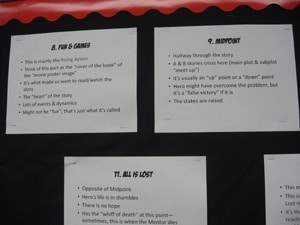
The impact of using Blake Snyder’s Beat Sheet has been immediately evident. For example, one of my classes lit up with excitement as we applied the Beats to a story. As we discussed the five stages of the Finale Beat, many of them began sharing their own discoveries as they thought of other films they could apply it to. At the time, one of my administrators was visiting our classroom and was smiling to see the students engaged and understanding the material. She later told me that as she watched a film, she began to apply it herself.
The wonderful thing about seventh graders is that they are brutally honest. They will tell you when something works for them and when something doesn’t. And the Blake Snyder Beat Sheet works. I decided to gather feedback, listening to the students. One student said that she usually misses a lot during movies and doesn’t understand things, but by using the Beat Sheet, she realized that she remembered more than she thought. By reflecting on a story using the Beat Sheet as a framework, the students have a more effective way to organize the plot. Of course, it’s always fun when students get so excited about the lesson that they write things like, “Just saying the ‘rising action’ is dumb; you can’t categorize half a movie into the same thing.”
Here are some of my favorite comments from student responses about what the Blake Snyder Beat Sheet taught them:
* How to analyze the meaning of the story.
* It will show me how everything clicks together.
* The biggest thing was the B Story. I never even thought about that.
* I can understand the story better. I can guess the theme in the beginning instead of going through the whole story to the end.
* The Blake Snyder Beat Sheet is so much easier to break down a story with than the traditional plot structure.
* Traditional plot structure is so vague that it’s hard to use it effectively.
* I think I’ll use it when writing stories because I used to just write without planning.
* It’s easier because it’s quicker to tell where [an event] goes instead of saying “rising action—from page 100-250.”
* It gets you excited on what is going to happen.
Of course, this is only a sample, but it’s a good representation of our classroom consensus. As I continue to use it, I remind students that we still need to understand the traditional plot structure, but this will make things easier. Collectively, my students and I have applied it in other situations. For example, when summarizing, it’s often difficult for students to know what to include, and they often write too little or too much without focus. Instead, we discussed four Beats they can combine into an good, basic summary: the Set-Up, the Catalyst, some of the Fun & Games, and the Finale.
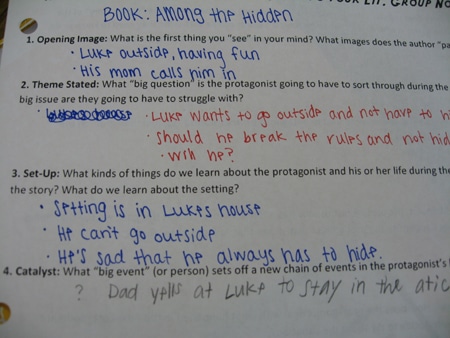
I am excited and encouraged to use the Blake Snyder Beat Sheet in my classroom, and I truly believe that his Save the Cat! books have transformed my teaching. True, it is more rigorous to use the Beat Sheet, but it is also much more relevant for my students, much more real. I beam with pride as I see how well the students apply it to their reading with a better understanding than they would have without it. Perhaps the most rewarding thing for me is to hear them use the Blake Snyder Beat Sheet terminology in their everyday classroom conversations, a trend that I know will continue for years to come.
Cory Milles
10 Comments
Leave a Reply Cancel reply
You must be logged in to post a comment.


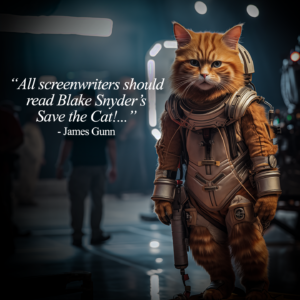
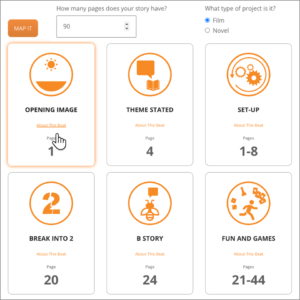
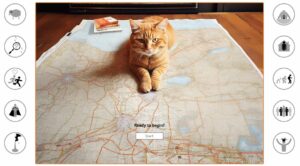




Cory, good on ya! Loved the blog, and the student comments. It is interesting how the education of STC can impact lives in ways greater than just writing.
What a great idea! You’ve probably just made a huge difference in these kids’ lives. It will be interesting to follow them and see what they create.
Cory,
I was a high school SHOP teacher. We built things. I required a written description and a mechanical drawing, to scale, before anything could be built. The idea on paper and blueprnt also had to be within accepted norms and industry standards. For example. A drawing of a boat submitted to be constructed would actually have to float.
It’s wonderful! that this process is exactly what you are teaching your kids if you can get them to stick with it!
NEXT thing to happen. They all are going to run out and film something now that you have planted the movie seed in them.
None will write a script for a 5 minute video at the car wash.
Using the CAT 15 beats, have them write a 5 minute video at the carwash and then produce and film it.(the “all is lost” moment is paper confetti on a wet car)
They will be WAY ahead of many professionals in our video industry and film school graduates.
Sincerely, Captain
OMG! I’m sorry I didn’t recognise you!
“RADAR?”
I love this blog ….. I am a drama and english teacher and also use the beats with my kids when looking at structure — I get my Grade 12 kids to read Save the Cat and they love it! Blake was a true teacher …… ‘To Teach is to Touch a Life Forever’ ——he touched so many lives! Here’s to the kittens of our community – Blake would have loved this blog I’m sure!
This is fantastic Cory! I wish more schools in the UK would teach the STC method of creative writing! From little ‘pussy cats’ grow mighty cats!
Thank you for the comments. I have enjoyed seeing my students expand their thinking, and I hope the trend continues. If anyone would like me to send you the resources I have created for using the Blake Snyder Beat Sheet in the classroom, e-mail me and I will send them to you.
Cory,
What a great idea. How brilliant to enrich the students’ understanding of story. As a writer with a ten-year-old, I’ve introduced some of the ideas in STC to my daughter and she was very interested. Given your example, I’d like to introduce the idea to her of breaking down the stories she enjoys. Their school has just started a book club and I think I’ll have her use the beat sheet to start some discussion with the other students.
As a student, I never fully grasped the whole ‘rising action’ and ‘falling action’ concepts. Neither did the Syd Field concepts work for me. Blake’s explanations and structure are the best ways to teach filmic structure to students (and adults!). When my 7-year old son can watch a Chipmunk movie and correctly announce out loud ‘This is the All is Lost moment, right?’ you know that Blake’s system is the best.
Cory,
If you think it’s appropriate, I am interested in using your material in a cat group that I will be starting at a Tech school that teaches filming mechanics and nothing about writing. [email protected]
Perry